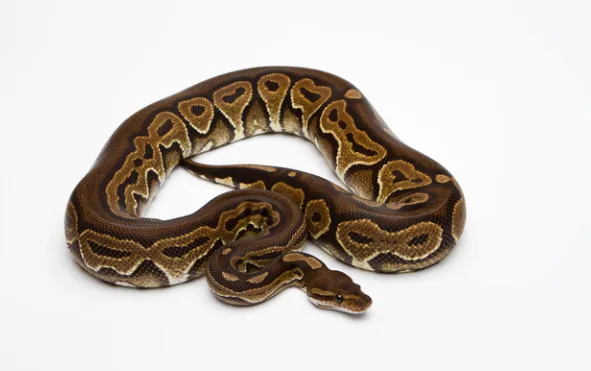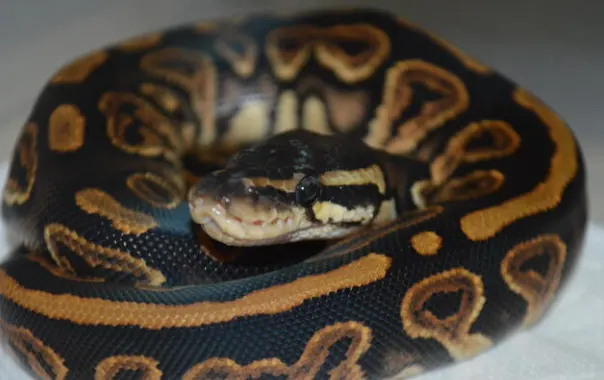The black pastel ball python (Python regius) is a captivating morph of the well-loved ball python, renowned for its distinctive, high-contrast coloration. Bred for the first time in 2002 by Gulf Coast Exotics, this morph quickly became a favorite among reptile enthusiasts. Here, we explore the various aspects of the black pastel ball python, from its physical characteristics to its behavior and care requirements.
Table of Contents
Overview and Classification
The black pastel ball python is a morph of the ball python, scientifically named Python regius. This name translates to “royal python,” a nod to the snake’s regal appearance and historical significance. Ball pythons are native to Sub-Saharan Africa and are typically found in savannas, grasslands, and forests. Despite their wild origins, ball pythons have become one of the most popular pet reptiles worldwide due to their manageable size, docile nature, and fascinating morphs.

Scientific Classification
- Kingdom: Animalia
- Phylum: Chordata
- Class: Reptilia
- Order: Squamata
- Family: Pythonidae
- Genus: Python
- Species: Python regius
Physical Characteristics
The black pastel ball python is distinguished by its warm, earthy-toned coloration and high-contrast markings. The base color of these snakes is typically a dark brown to black, accentuated by golden yellow patterns. This morph’s coloration is more vibrant and contrasting compared to the standard wild-type ball python, with a richer, warmer, and more golden sheen.
Identifying Traits
- High Contrast: The black pastel morph exhibits a stark contrast between its base color and its patterns, making it visually striking.
- Golden and Rust Tones: The patterning often features shades of gold, rust, or even reddish tones, adding to its unique appearance.
- Reduced Belly Pattern: The ventral side usually has reduced or broken-up patterns, though this can vary among individuals.
Evolution and History
The black pastel morph was first bred in captivity by Gulf Coast Exotics in 2002. The aim was to create a ball python with more vibrant and high-contrast coloration. As a co-dominant trait, only one black pastel parent is required to produce offspring with this morph. When two black pastel snakes are bred together, they can produce the super black pastel morph, characterized by a nearly solid black or chocolate brown coloration with minimal patterning.
Over the years, breeders have used the black pastel trait to develop various other morphs, including the panda pied and the silver surfer, both of which are highly sought after in the exotic pet trade.
Habitat and Natural Environment
In the wild, ball pythons inhabit a range of environments across western and central Africa, including savannas, grasslands, and forests. These habitats provide ample cover and opportunities for ambush hunting, which is the ball python’s preferred method of capturing prey.
Behavior and Temperament
Black pastel ball pythons share the same docile and curious temperament as other ball python morphs. They are generally solitary animals, coming together only to mate. These snakes are nocturnal, meaning they are most active during the night.
When threatened, ball pythons exhibit a unique defensive behavior: they curl up into a tight ball, protecting their head in the center. This behavior is where they get their common name, “ball python.”
Interaction with Humans
Due to their calm and hardy nature, black pastel ball pythons are a popular choice for both novice and experienced reptile keepers. They rarely show aggression towards humans and can be easily handled with proper care.
Diet and Feeding
In the wild, ball pythons primarily prey on small rodents and birds. In captivity, they are typically fed captive-raised mice and rats. Juveniles should be fed once a week, while adults can be fed every one to two weeks, depending on their size and metabolism.
Reproduction
Ball pythons are oviparous, meaning they lay eggs. A typical clutch consists of five to ten eggs. Breeding black pastel ball pythons involves pairing a black pastel with another ball python, either of the same morph or a different one to create new morphs. The eggs incubate for about 55 to 60 days before hatching.
Common Genetic Defects
While the black pastel morph is generally healthy, it does have a few common genetic defects. These include slight tail kinking and occasionally a mildly deformed “duckbill” face. Fortunately, these defects are relatively rare and do not significantly impact the snake’s overall health or lifespan.
Conservation Status
The ball python is classified as Near Threatened due to habitat loss and hunting pressures. Although populations have been decreasing, the black pastel morph itself is primarily bred in captivity and is not directly affected by these threats.
Purchasing and Care
Black pastel ball pythons are readily available and affordable within the exotic pet trade. Prices typically range from $100 to $300, depending on the breeder, the snake’s patterning, and current market demand. More complex morphs involving the black pastel trait, such as the panda pied, can be significantly more expensive.
Housing
A proper enclosure for a black pastel ball python should mimic its natural habitat. A 20-gallon tank is suitable for juveniles, while adults may require a 40-gallon tank or larger. The enclosure should include hiding spots, a water bowl, and a heat source to maintain a temperature gradient.
Temperature and Humidity
Maintaining the correct temperature and humidity levels is crucial for the health of a ball python. The warm side of the enclosure should be kept at around 88-92°F, while the cool side should be around 78-80°F. Humidity levels should be maintained between 50-60% to ensure proper shedding.
Substrate
Suitable substrates for ball pythons include aspen shavings, cypress mulch, and coconut husk. These substrates help maintain humidity and provide a comfortable surface for the snake to burrow.
Health and Veterinary Care
Regular health check-ups are essential for ensuring the well-being of a black pastel ball python. Common health issues include respiratory infections, mites, and scale rot. A reptile veterinarian can provide the necessary care and guidance to address these issues.
Q&A Section
Are black pastel ball pythons venomous?
No, black pastel ball pythons, like all ball pythons, are non-venomous constrictor snakes. They lack fangs and have small, weak teeth.
How do black pastel ball pythons hunt?
Ball pythons are ambush hunters. They wait for a prey animal (usually a small rodent or bird) to cross their path before striking and latching onto the animal with their jaws. They then coil their body around the prey to suffocate it before swallowing it whole.

Are black pastel ball pythons aggressive?
No, black pastel ball pythons are generally not aggressive towards humans. They are known for their docile and slightly timid temperament.
Where do black pastel ball pythons live?
Ball pythons are native to Sub-Saharan Africa, where they prefer savannas, grasslands, and forests. Black pastel ball pythons can occur naturally in the wild, though this is rare. Most are bred in captivity.
What do black pastel ball pythons eat?
In the wild, ball pythons primarily eat small rodents and birds. In captivity, they are typically fed captive-raised mice and rats.
How much do black pastel ball pythons cost?
Black pastel ball pythons typically cost around $100 to $300. However, more complex designer morphs involving the black pastel trait, such as the panda pied, can cost significantly more, often exceeding $1,500.
Are black pastel ball pythons rare?
While black pastel ball pythons are extremely rare in the wild, they are very common, affordable, and easily accessible within the exotic pet trade today. They are one of the more affordable morphs due to their simplicity and ease of breeding.
The black pastel ball python is a stunning and fascinating morph that continues to captivate reptile enthusiasts. Its high-contrast coloration, docile temperament, and manageable care requirements make it an excellent choice for both novice and experienced reptile keepers. With proper care and attention, a black pastel ball python can thrive in captivity and provide years of companionship.
- Enchi Ball Python: A Unique and Stunning Morph of Python regius - March 27, 2025
- Emerald Tree Monitor: The Enigmatic Green Guardian of the Rainforest - March 26, 2025
- The Egyptian Cobra (Naja haje): A Fascinating Serpent - March 25, 2025
